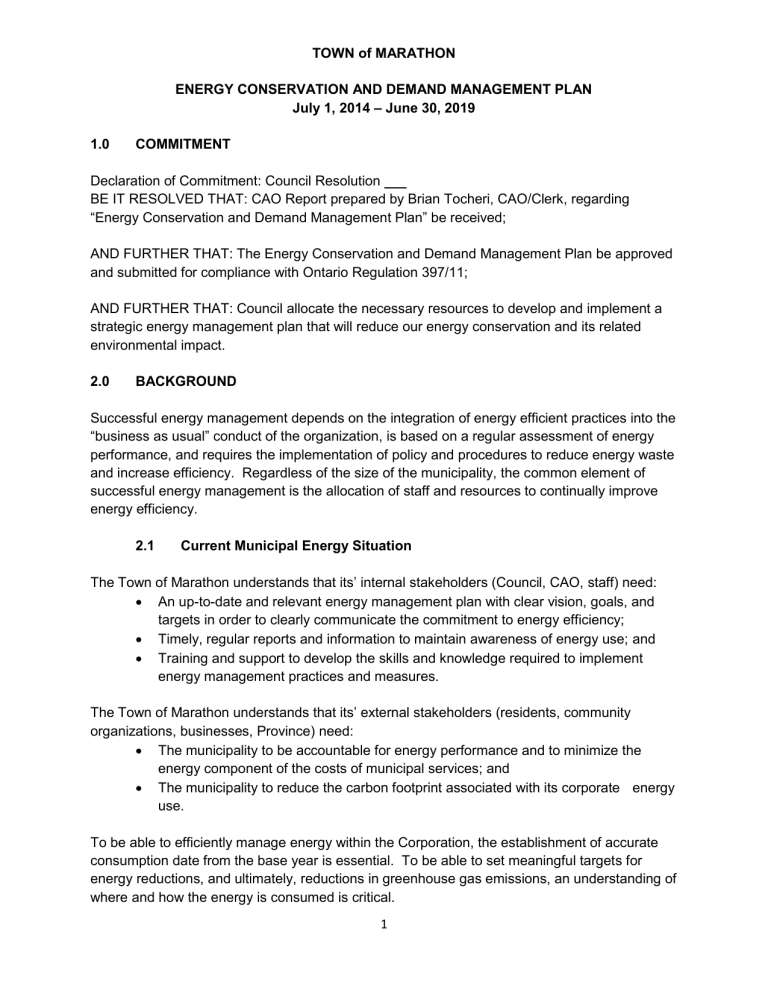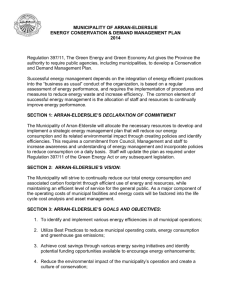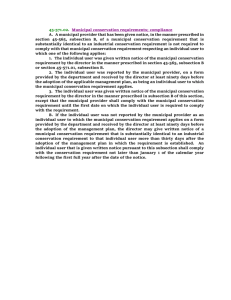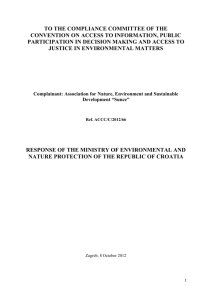TOWN of MARATHON ENERGY CONSERVATION AND DEMAND

TOWN of MARATHON
ENERGY CONSERVATION AND DEMAND MANAGEMENT PLAN
July 1, 2014 – June 30, 2019
1.0 COMMITMENT
Declaration of Commitment: Council Resolution
BE IT RESOLVED THAT: CAO Report prepared by Brian Tocheri, CAO/Clerk, regarding
“Energy Conservation and Demand Management Plan” be received;
AND FURTHER THAT: The Energy Conservation and Demand Management Plan be approved and submitted for compliance with Ontario Regulation 397/11;
AND FURTHER THAT: Council allocate the necessary resources to develop and implement a strategic energy management plan that will reduce our energy conservation and its related environmental impact.
2.0 BACKGROUND
Successful energy management depends on the integration of energy efficient practices into the
“business as usual” conduct of the organization, is based on a regular assessment of energy performance, and requires the implementation of policy and procedures to reduce energy waste and increase efficiency. Regardless of the size of the municipality, the common element of successful energy management is the allocation of staff and resources to continually improve energy efficiency.
2.1 Current Municipal Energy Situation
The Town of Marathon understands that its’ internal stakeholders (Council, CAO, staff) need:
An up-to-date and relevant energy management plan with clear vision, goals, and targets in order to clearly communicate the commitment to energy efficiency;
Timely, regular reports and information to maintain awareness of energy use; and
Training and support to develop the skills and knowledge required to implement energy management practices and measures.
The Town of Marathon understands that its’ external stakeholders (residents, community organizations, businesses, Province) need:
The municipality to be accountable for energy performance and to minimize the energy component of the costs of municipal services; and
The municipality to reduce the carbon footprint associated with its corporate energy use.
To be able to efficiently manage energy within the Corporation, the establishment of accurate consumption date from the base year is essential. To be able to set meaningful targets for energy reductions, and ultimately, reductions in greenhouse gas emissions, an understanding of where and how the energy is consumed is critical.
1
The 2012 baseline data provides a starting point and template for the continued tracking and monitoring of all Corporate energy data. This data highlights areas for potential energy efficiency and conservation efforts. Due to the continual increasing costs of energy, it is vital that the Corporation reduces its energy consumption.
2.2 Baseline Energy Consumption and Demand
2012 will be used as the baseline for all municipal energy use. For comparison purposes, the
2011 and 2012 propane, electricity and fuel oil energy usage by building is detailed in the attached spreadsheets. The accompanying table shows the areas of relative energy use.
2.3 How Energy is Currently Managed
The management of our energy is a combination of energy data management, energy supply management and energy use management. Our energy management data is managed by
Department Managers and the Treasurer. The data is received via supplier invoices, then tracked and/or monitored using the AMO/LAS Energy Planning Tool (EPT).
2.4 Energy Supply Management
Our municipal energy is supplied via a number of suppliers as outlined:
Electricity is supplied by Hydro One on an as-needed basis and is priced at the standard rates offered by the provider. In 2014, the Town entered into the LAS’
Electricity Procurement Program whereby 65% of our electricity is hedged using competitive tenders and the balance is moved to spot market pricing.
Propane is supplied by a local propane provider on an as-needed basis. Pricing and service is tendered every three years.
The Town is also a member of LAS’ Fuel Procurement Program. The LAS program offers reduced pricing for diesel, gasoline and fuel oil by grouping individual members’ purchases. The prices are tied to supplier-published wholesale or rack prices on a weekly basis.
Aircraft fuel is purchased by a regional provider and is priced at standard rates offered by the supplier.
2.5 Energy Use Management
Day-to-day management of energy has been primarily the responsibility of the Department
Managers and Treasurer. To aid in our efforts to track and reduce energy use, the Town of
Marathon uses LAS’ Energy Management Tool (EMT) and Energy Planning Tool (EPT).
3.0 OUR PLAN
3.1 Goals
To improve the energy efficiency of our facilities by utilizing best practices to reduce our operating costs, energy consumption and greenhouse gas emissions;
2
To implement a comprehensive corporate energy management program to reduce consumption, achieve costs savings, and meet greenhouse gas emission targets;
To create a culture of conservation ;
To increase the comfort and safety of staff and patrons of the Town of Marathon facilities; and
To improve the reliability of the Town ’s equipment and reduce maintenance.
3.2 Objectives
1. To further investigate and implement recommendations from previous energy audits on municipal facilities;
2. To undertake/implement energy audits on all remaining municipal facilities during the next five years;
3. To reduce total energy consumption in municipal facilities, normalized to weather conditions, by 15% over the next five years;
4. To reduce energy consumption in the recreation complex (pool/arena) by 10% by 2016 and an additional 5% by 2019;
5. Explore and take advantage of incentives and programs offered by various providers and agencies wherever possible;
6. Improve the efficiency of energy use through low-cost opportunities by implementing the following:
sound operating and maintenance practices;
employee training and awareness; and
monitoring and tracking systems.
7. To decrease energy and fossil fuel consumption and reduce greenhouse gas emissions at the municipal level by:
reducing building energy demand in all Town facilities;
ensuring wise energy use in all municipal buildings;
continuing to audit Town buildings for energy use; and
conducting a greenhouse gas emission inventory and set reduction targets as part of a climate change adaption strategy.
8. To continue to produce solar energy on two municipal facilities (10kW systems).
3.3 Strategic Planning
Long-term strategic issues: We will develop and implement energy policies, organize for energy management, develop the required skills and knowledge, manage energy information, communicate with our stakeholders, and invest in energy management measures.
Links with other municipal plans and management processes: As an integral component of the management structure, the energy management plan is to be coordinated with the municipality’s budget planning, strategic plan, preventative maintenance plans, environmental management plan, asset management plan, municipal leases and agreements, and the policy development process.
3
Procurement planning: Energy efficiency will be considered by staff prior to procurement and documents being published for tender. The intent is to make energy management part of the Town’s normal course of business for all facility and operational retrofits, including capital renewal and life cycle replacement projects.
Incorporating energy efficiency options at the initial stages of a project design ensures that options for improving energy efficiency are considered, evaluated and quantified in terms of life cycle costing analysis, including cost, maintenance and emission reductions.
Departmental responsibilities: We will incorporate energy budget accountability into our corporate responsibilities.
3.4 Energy Management Team
Energy Team: We will identify staff members and personnel who have responsibility for energy performance or who can provide essential input into energy management processes.
Staff Requirements and Duties: We will incorporate energy efficiency into standard operating procedures and the knowledge requirements for operational jobs. All staff members will be made aware of the Town of Marathon’s energy conservation efforts and why they’re important. Staff will be expected to make any changes they can in their daily routines that could help reduce energy consumption, as well as keep up with operational standards. Staff will be updated about the results of energy audits and be given suggestions on how to improve their energy consumption at their jobs.
Updates on their rate of success or improvement will also be given to staff members so they will be encouraged to continue their efforts.
External Consultants and Energy Suppliers: We will establish criteria in our
Procurement Policy for the selection of external consultants and energy suppliers based on our energy goals and objectives.
3.5 Staff Training and Communication
Communication Programs: We will develop a communication strategy that creates and sustains awareness of energy efficiency as a corporate priority among all employees and conveys our commitment and progress to our stakeholders.
Energy Awareness Training: We will develop and deliver training focused on the energy use and conservation opportunities associated with employees’ job functions wherever possible.
Energy Skills Training: We will develop and deliver skills training for operators, maintainers and other employees that have “hands-on” involvement with energy consuming systems in order to improve the team’s ability to achieve energy efficiency improvements.
Business Procedures: We will carry out a comprehensive review of all business processes and modify them as necessary in order to incorporate any efficiency considerations.
4
3.6 Investment Planning
We will create a Continual Energy Improvement Fund . Contributions to the fund will be made through savings from energy conservation projects. The L.E.D Streetlight Conversion Project, scheduled to be completed in 2014 could be the basis of the Fund whereby a portion of the energy savings (e.g., 40% or $26,000) generated from the project could be used to explore and fund further energy efficiencies. This would place the municipality in a good position to meet the current requirements and objectives of its energy conservation and demand management plan.
3.7 Review
At least annually, we will:
Review energy savings opportunities and measures taken across the municipality;
Report to Council on savings; and
Identify further savings opportunities: o Low/no cost options; o More complex options; and o Partnership prospects.
3.8 Evaluation Progress
Our Energy Consumption from buildings in 20 was reduced to our 20 levels of GJ.
Energy from buildings in 20 our corresponding
GJ from
Greenhouse Gas Emissions are GJ from propane consumption and consumption. This represents a
GJ from
% reduction in propane and electricity
% reduction in electricity over our 2012 levels.
We have reduced our energy costs from buildings by % in absolute terms, in the face of marginal increases in energy prices.
5







